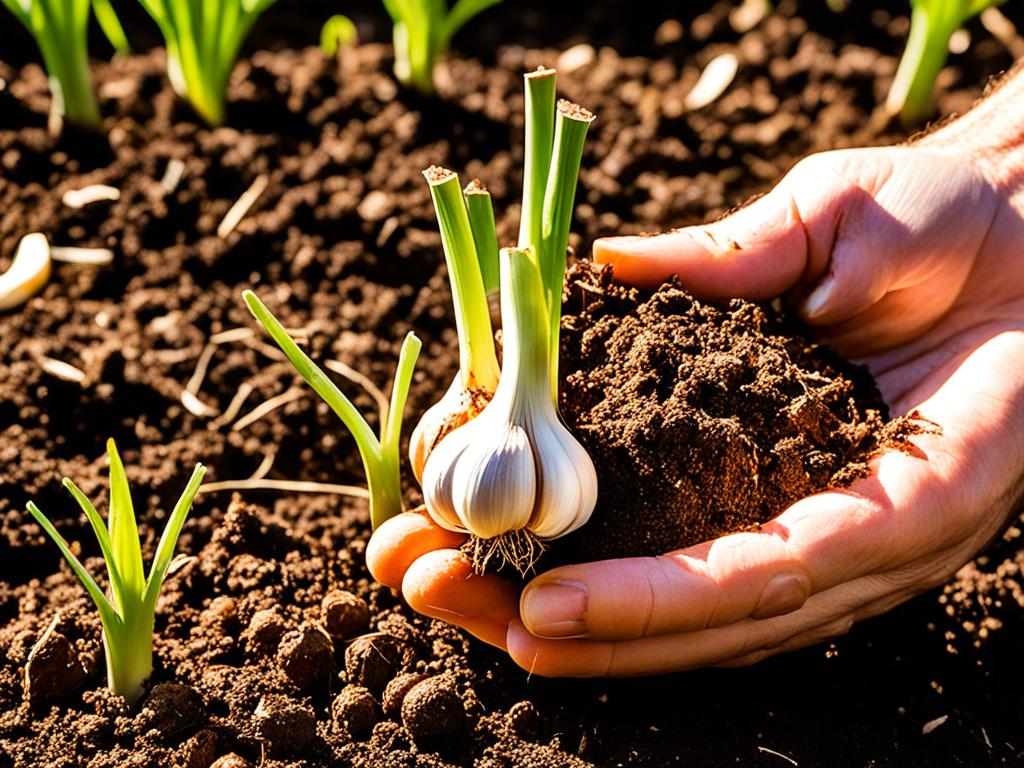Are you ready to start growing your own garlic? This guide is perfect for both seasoned gardeners and beginners. I’ll share all the key steps to plant, grow, and harvest garlic at home. You’ll learn how to pick the best variety and store your garlic, ensuring a fresh and aromatic harvest.
Growing garlic is rewarding and easy with the right knowledge. This guide will take you through everything from choosing the right type to the best ways to plant and care for it. By the end, you’ll know how to grow your own garlic from a simple clove.
Let’s start our garlic growing journey. This guide is great for adding fresh flavor to your cooking or trying a new gardening project. You’ll get all the info you need to begin. Get ready to enjoy the fruits of your labor with your homegrown garlic!
Introduction to Growing Garlic
Growing garlic is a rewarding and easy gardening project. It has been grown for centuries and is a key ingredient in many cuisines. By growing your own garlic, you get to enjoy fresh, aromatic bulbs and control the growing process.
Garlic is packed with health benefits, like antioxidants and immune system support. It’s also very versatile in cooking, adding depth to many dishes. Whether you’re experienced or new to gardening, growing garlic is rewarding and tasty.
This article will guide you through planting, caring for, and harvesting your own garlic. You’ll learn about choosing the right garlic cultivation varieties and curing and storing your garlic. You’ll see how to enjoy the benefits of growing garlic in your garden or backyard.
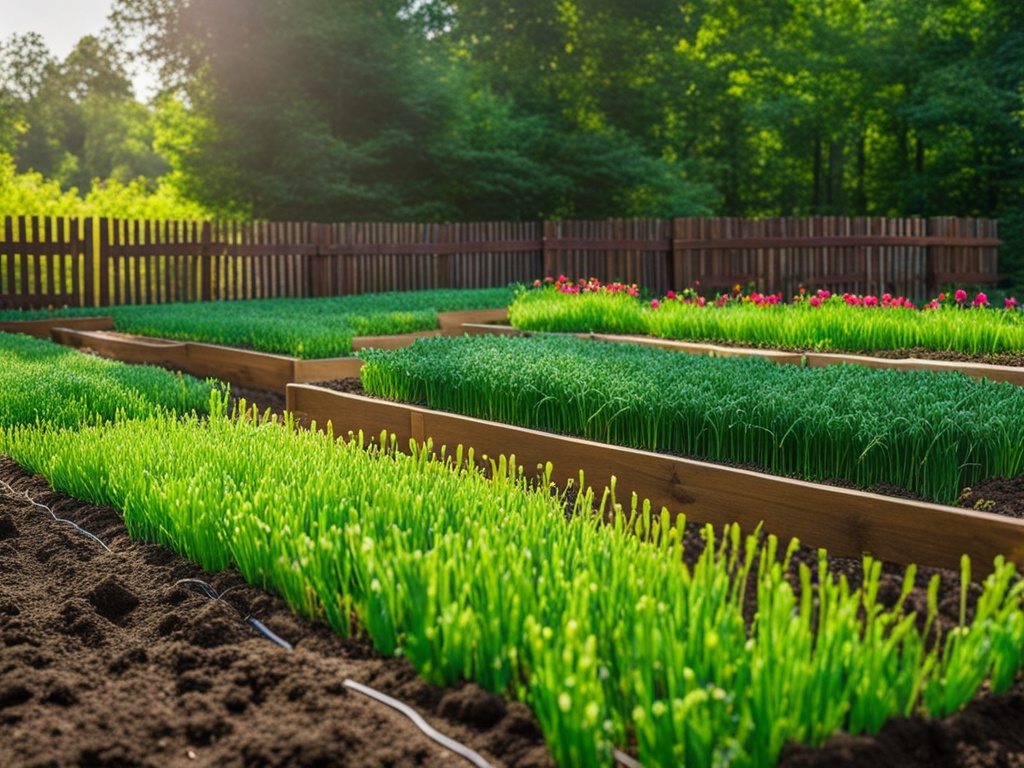
Growing garlic is easy and doesn’t need much upkeep. With proper soil and planting, you’ll get a lot of tasty garlic bulbs. Let’s start your journey to growing garlic successfully!
Choosing the Right Garlic Variety
When growing garlic, you have two main types to pick from: hardneck and softneck. Each type has its own special traits. Choosing the right one can greatly affect your harvest.
Hardneck Garlic
Hardneck garlic has a stiff stem, or scape, in the middle of the bulb. This scape is tasty and can be picked in spring. Hardneck garlic tastes stronger than softneck and includes Porcelain, Rocambole, and Purple Stripe types.
Softneck Garlic
Softneck garlic has a soft stem great for braiding. It tastes milder and keeps well for a long time. Silverskin and Artichoke are common softneck types. Softneck grows well in warm places, while hardneck does better in cold areas.
Think about your climate, growing conditions, and taste likes when picking garlic. Trying different types can be fun and help you find your favorite for your kitchen garden.
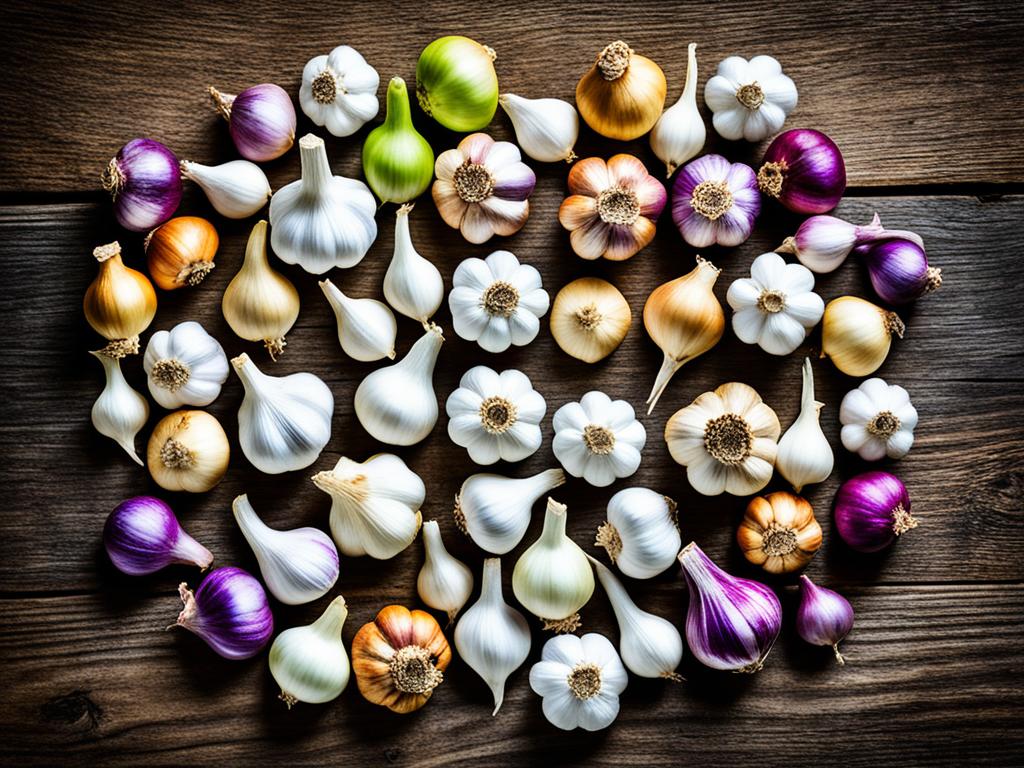
| Hardneck Garlic | Softneck Garlic |
|---|---|
|
|
The choice between hardneck and softneck garlic is not just about taste. It’s also about your garden and what you like. Try different types to see which is best for you.
Best Time to Plant Garlic
Planting garlic at the right time is key. You can plant garlic in the fall or spring, but fall is best. About 90% of garlic is planted in the fall, while 10% is planted in the spring.
Fall Planting
The best time to plant garlic in the fall is 2-4 weeks before the first frost. This lets the garlic get the chill it needs for growing big bulbs. Hardneck garlic, which doesn’t last long, does well in cold places and is great for fall.
Spring Planting
For spring planting, start early to give garlic 6-8 weeks of cool weather. This cold period helps garlic grow big and tasty, just like fall-planted garlic. But, spring garlic usually doesn’t grow as much as fall garlic.
Choosing between fall and spring planting depends on your area and what you like. Knowing the best times to plant can help you grow great garlic at home.

Preparing the Planting Bed
To get a great garlic harvest, start with the right planting bed. Garlic does well in soil that drains well and is full of nutrients. Before planting garlic cloves, I add compost or organic matter to the soil. This boosts drainage and makes the soil richer, helping my garlic grow strong and healthy.
I look for a spot that gets at least 6 hours of sunlight a day. This spot should also be quiet during the 8-month growing season. A soil pH between 6.0 and 7.0 is perfect for garlic, so I aim for that.
| Soil Requirement | Ideal Range |
|---|---|
| pH | 6.0 – 7.0 |
| Organic Matter | Amended with compost |
| Drainage | Well-drained |
| Sunlight | 6+ hours of direct sunlight |
Preparing the garlic bed well sets the stage for a great harvest. The right soil and sunlight are key for garlic soil requirements. By focusing on preparing the garlic planting bed, I make sure my garlic soil preparation is spot on.
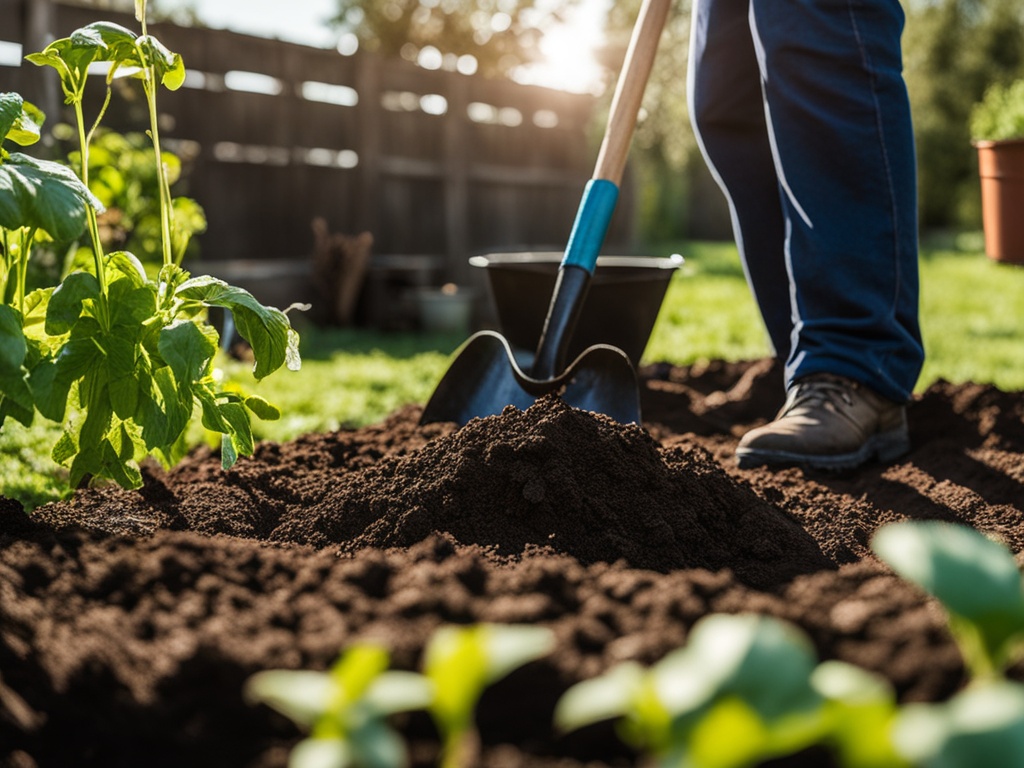
“Healthy soil is the foundation for a thriving garlic crop. Take the time to get your planting bed just right, and you’ll be rewarded with a bountiful harvest.”
How to Plant Garlic Cloves?
Planting garlic is easy and can lead to a big harvest with the right care. Start by separating the garlic bulb into individual cloves, keeping the papery skin on. Place each clove pointy-side up, 1-2 inches deep in warm areas or 3-4 inches deep in cold ones.
It’s important to space cloves correctly for growth. Put them 6-8 inches apart in rows. This lets the plants grow well and prevents overcrowding and bad airflow.
Mulching for Fall Plantings
For fall garlic plantings, use a 4-6 inch layer of weed-free mulch like straw or dried leaves. This mulch does two things: it protects the bulbs from extreme temperatures and keeps the soil moist. This creates the perfect setting for garlic to grow strong roots and become big, healthy plants.
| Planting Depth | Planting Spacing |
|---|---|
| 1-2 inches (Warmer Climates) | 6-8 inches Apart |
| 3-4 inches (Colder Regions) | 6-8 inches Apart |
By using these tips for how to plant garlic, garlic planting depth, garlic planting spacing, and garlic mulching, you’ll be on your way to a great garlic harvest. Remember, the secret to successful garlic is starting right.
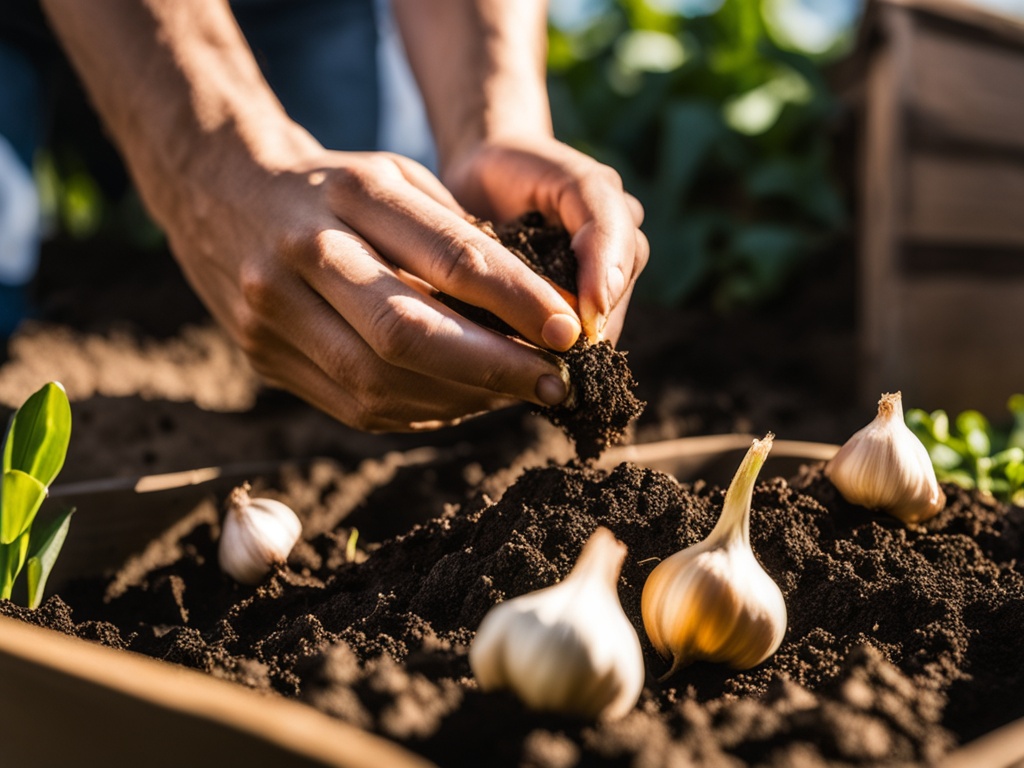
Caring for Growing Garlic Plants
Looking after your garlic plants is key for a great harvest. As they start to grow, it’s time to care for them. Pull back the mulch and water them regularly, giving them about 1 inch of water each week. This keeps the garlic well-hydrated and healthy.
In spring, when the garlic grows fast, give it balanced fertilizer and compost. This helps the garlic grow strong bulbs. Make sure to weed the garlic bed often, as garlic doesn’t like sharing space with other plants.
Dealing with Pests and Diseases
Keep a close eye on your garlic for pests like cutworms, leafminers, and onion thrips. These pests can harm your plants. If you find them, use a safe insecticide to control them.
Fungal diseases like botrytis blight and downy mildew can hit garlic too. Use a fungicide to fight these diseases. By acting fast and keeping an eye out, you can keep your garlic plants healthy all season.
| Pest or Disease | Symptoms | Treatment |
|---|---|---|
| Cutworms | Severed stems at the soil line | Apply insecticide or use row covers |
| Leafminers | Serpentine tunnels in leaves | Use insecticidal soap or remove affected leaves |
| Onion Thrips | Silvery, distorted leaves | Spray with insecticidal soap or neem oil |
| Botrytis Blight | Gray mold on leaves and stems | Apply a fungicide containing chlorothalonil |
| Downy Mildew | Yellow, splotchy leaves | Use a fungicide containing copper or mancozeb |
By following these tips, you’ll be on your way to a great garlic harvest. A bit of extra care means your garlic will do well all season.
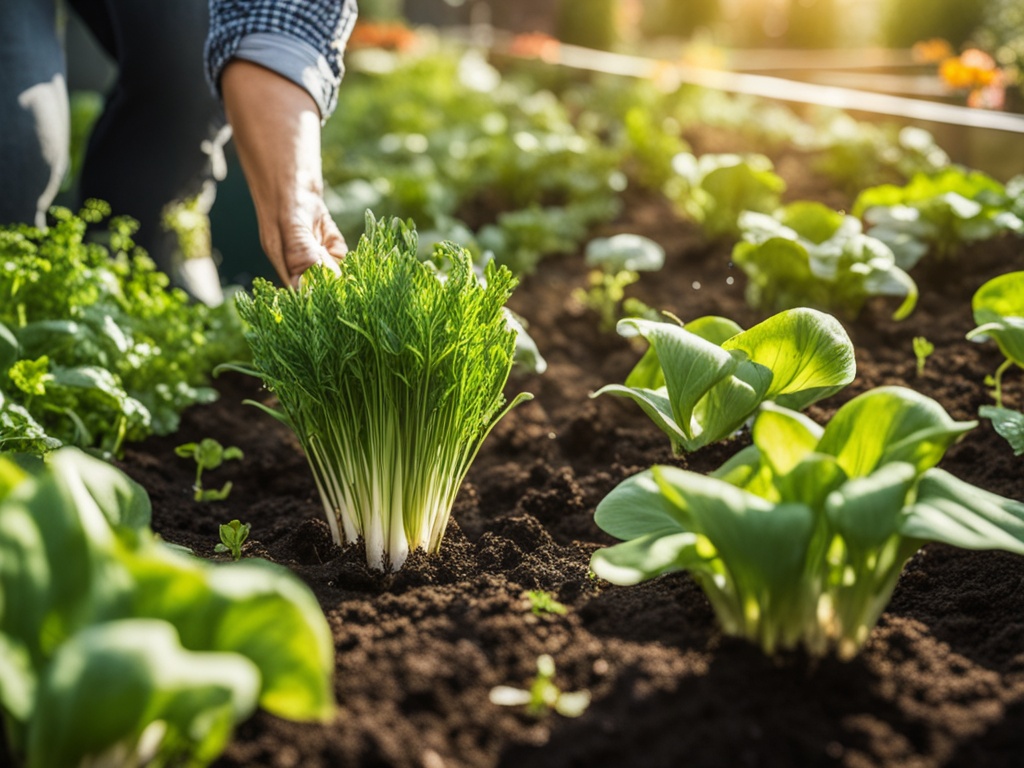
How to Grow Garlic?
Garlic is easy to grow and perfect for beginners. After planting the cloves, it needs little care. The plants grow their leaves and bulbs, needing only water, weeding, and some fertilizer. With the right steps, you can have a lot of fresh garlic from your garden.
First, pick the right garlic type for your area. Hardneck garlic works well in zones 7 and colder. Softneck garlic is better for warmer areas.
Garlic takes about 8 months to grow and needs cool weather to develop. Plant it in the fall for the best results. Use grass clippings or dry leaves as mulch to help it grow.
Water and feed your garlic plants when they need it. In mid-June, cut off the scapes to help the bulbs grow bigger. By late August, your garlic should be dry and ready to store.
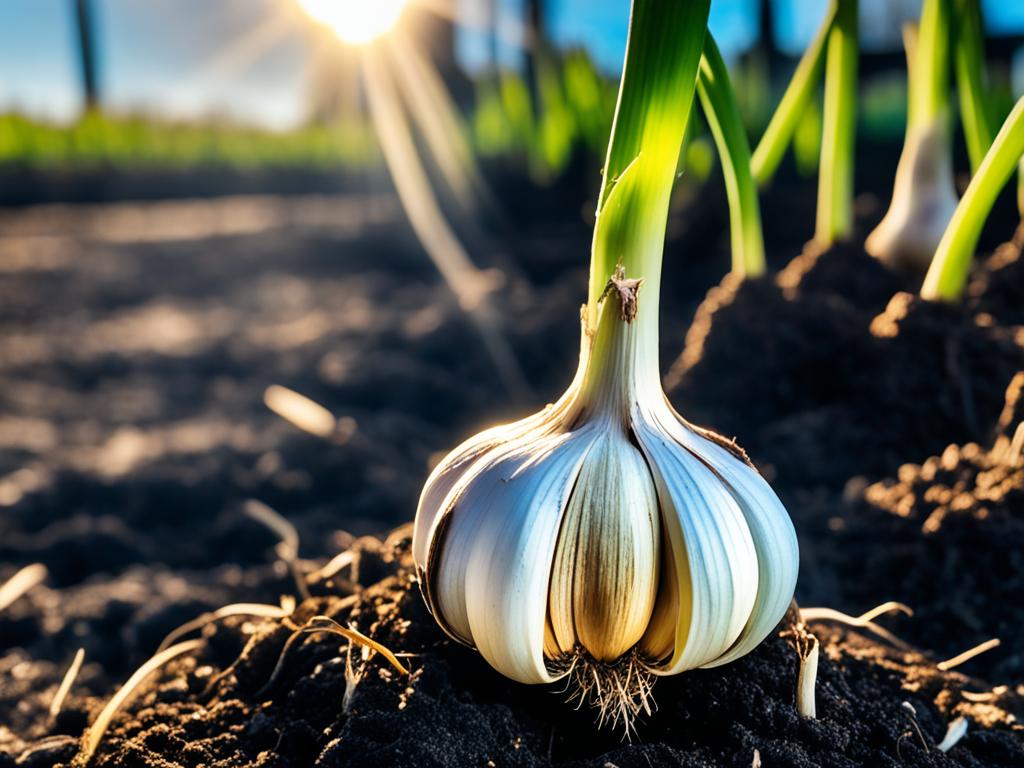
Look for signs like yellow leaves and bulbs pushing up to know when to harvest. Store your garlic in a cool, dry place for up to 6 months.
Follow these steps to grow your own delicious garlic. Enjoy your gardening journey!
Harvesting and Curing Garlic
Knowing when to harvest your garlic and how to cure it is key for a good yield. Waiting too long can make the bulbs unsuitable for storage. The timing is everything.
Signs of Harvest Time
Garlic is ready when the leaves start to turn yellow and brown at the tips. The plant should be about one-third to one-half brown. This usually happens in mid-to-late July, but can vary by climate and planting conditions.
Most garlic varieties mature by the end of July. This is when you should harvest them.
Curing Process
- Carefully dig up the garlic bulbs, keeping the stems intact.
- Let the garlic “cure” or dry in a warm, well-ventilated area for 2-4 weeks. This process helps the garlic last longer.
- A well-cured hardneck garlic bulb will have a solid white stem about 4 inches above the bulb. It should also have a stiff, unbroken papery wrapping.
- Curing time can vary with the weather. Dry and hot weather helps it cure faster, usually in two weeks. But hot and humid weather can make it take longer.
- After curing, trim the stems to about 3 inches above the bulb. Then, you can store the garlic for a long time.
By following these steps for harvesting and curing your garlic, you’ll enjoy your homegrown crop for a long time.
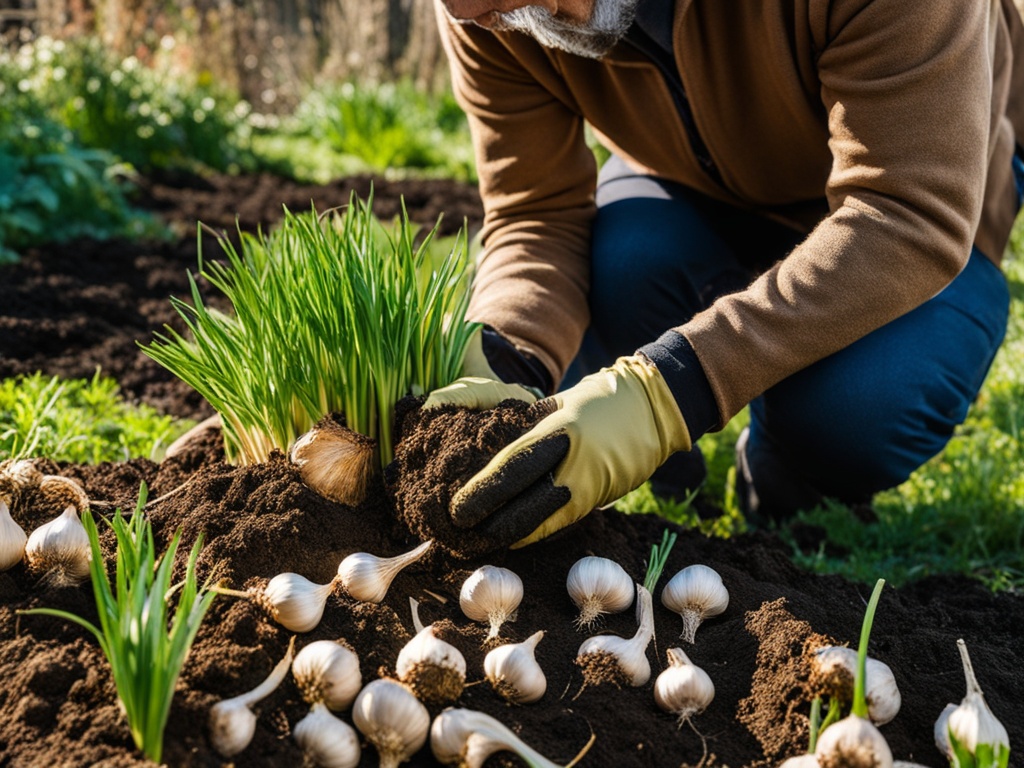
Storing Garlic for Long-Term Use
Properly cured and stored garlic can change the game in extending its shelf life. With the right storage methods, you can enjoy your homegrown garlic for up to 6 months or more. The key is knowing the best storage conditions and following simple steps to keep your garlic fresh and ready.
The best temperature for storing garlic is between 32°F and 40°F, like in a fridge or a cool, dark cellar. Don’t store garlic in the freezer as it can sprout, losing flavor and texture. Once your garlic is cured and ready for storage, pick the healthiest bulbs for future use.
Here are tips to extend your garlic’s storage life:
- Store garlic in a well-ventilated, dry, and dark place to prevent mold and sprouting.
- Keep garlic away from heat sources or direct sunlight to slow down deterioration.
- Keep the papery outer skins on the garlic bulbs to protect the cloves and keep moisture in.
- Use mesh bags, paper bags, or crates for storage to allow air flow and prevent moisture.
- Check your stored garlic often and remove any cloves that are spoiling or sprouting.
- Save some of your best bulbs as “seed” garlic for next year’s crop.
By following these easy tips, you can enjoy the tasty and versatile benefits of your homegrown storing garlic for months. With the right garlic storage methods, your kitchen will always have premium long-term garlic storage for your cooking.
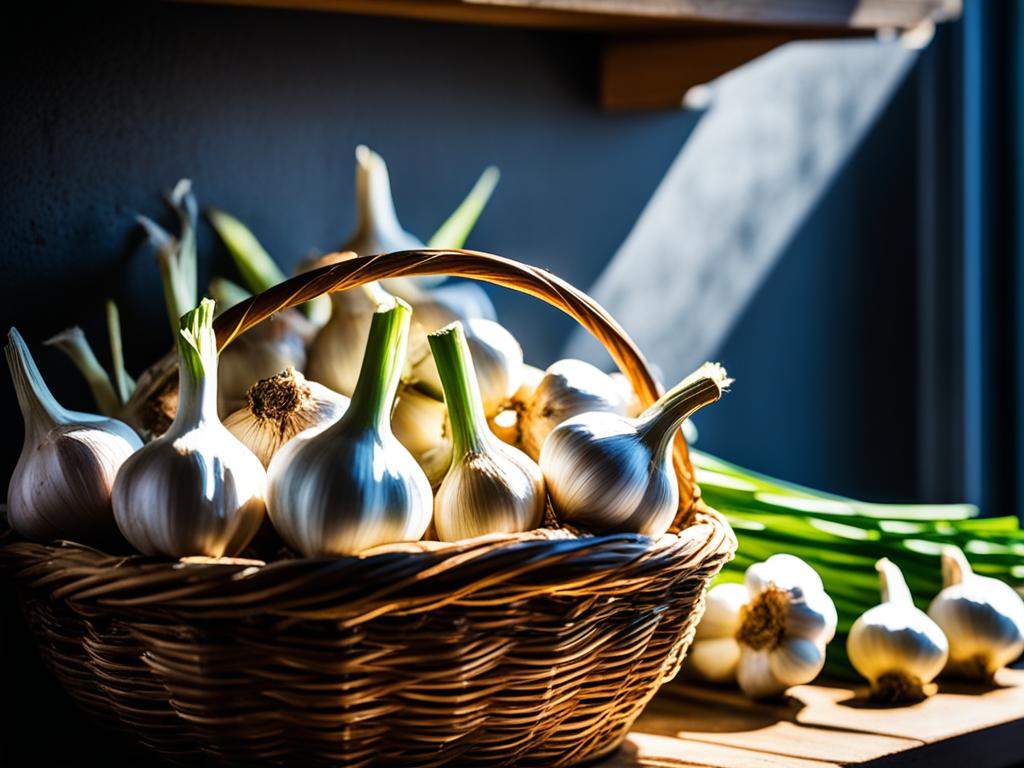
The secret to successful garlic storage is keeping the right temperature, humidity, and air flow. By curing and storing your garlic right, you’ll have a steady supply of this key ingredient for all your recipes.
Using and Enjoying Homegrown Garlic
Growing my own garlic has brought me so much joy. It adds flavor to many dishes and is good for my health. You can use it in many ways, like making roasted garlic or garlic-infused oils and pestos.
Using garlic from my garden means I get the freshest and most flavorful bulbs. It’s full of taste and is a superfood because of its health benefits. I enjoy trying out different recipes to show off the unique tastes of my garlic.
- Hardneck garlic, such as the spicy “Spanish Roja” and the complex “Chesnok Red,” lend themselves beautifully to roasted garlic dishes or garlic-infused oils.
- Softneck varieties like the mild “Inchelium Red” and the versatile “California Softneck” are perfect for garlic pestos, aiolis, and other sauces.
Garlic is not just tasty; it’s also good for my health. I use it in many ways, like sautéing it with veggies or making hummus. The smell alone makes me want to cook more with it. I’m proud to grow this amazing ingredient in my garden.

Exploring how to use garlic in my cooking is always exciting. It adds so much flavor and health benefits. I encourage everyone to try growing and enjoying garlic. It’s a rewarding experience that improves your cooking and health.
Common Problems When Growing Garlic
As a garlic grower, I’ve seen a few common issues that can affect garlic. Pests like cutworms, leafminers, and onion thrips can harm garlic plants. Fungal diseases such as botrytis blight and downy mildew can also be a problem. But, with the right soil care, pest control, and disease prevention, you can beat these issues and get a great garlic harvest.
Pests and Diseases
One big garlic problem I’ve faced is pests. Cutworms cut young garlic plants at the base, and leafminers make tunnels in the leaves. Onion thrips, tiny bugs, can slow down garlic growth. To fight these garlic pests, I use row covers, beneficial nematodes, and keep my garden clean.
Garlic diseases are another issue. Fungal problems like botrytis blight and downy mildew can hurt my garlic. To prevent these, I make sure to space my garlic well, improve air flow, and use fungicides if needed.
Soil and Climate Considerations
Getting the soil right is key for healthy garlic. Garlic does best in soil that drains well and is rich in nutrients, with a pH of about 6.5. Adding organic matter and enough nitrogen helps garlic grow big and strong. Also, planting garlic at the right depth and spacing makes for bigger bulbs.
Adjusting to the local climate is also important. In places with cold winters, softneck garlic might not do as well as hardneck types. Making sure garlic gets enough cold weather in the fall and winter is crucial for a good harvest.
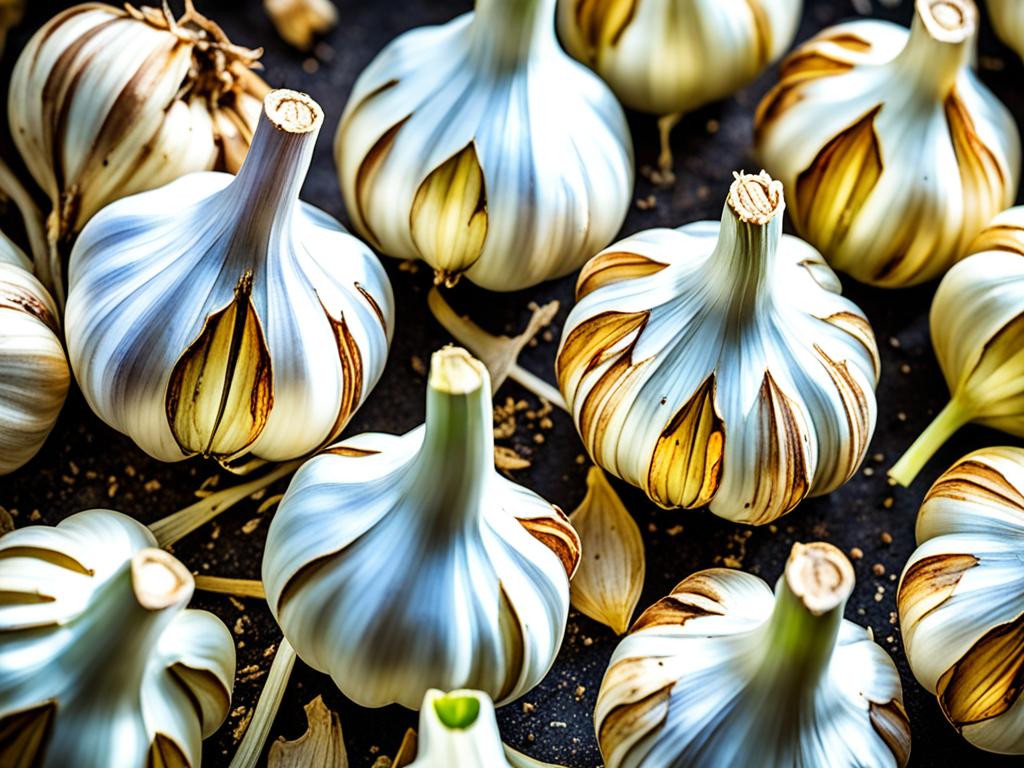
By tackling these common garlic problems, garlic pests, garlic diseases, and garlic growing issues, I’ve grown tasty, abundant garlic in my garden. With some extra care, you can do the same and enjoy the perks of growing your own garlic.
Conclusion
Growing your own garlic at home is easy and rewarding. It lets you enjoy fresh, flavorful bulbs right from your garden. This guide shows you how to plant, care for, and harvest your garlic crop. You’ll love the many uses and benefits of this versatile vegetable.
If you’re new to growing your own food, garlic is a great place to start. It’s easy to grow and becomes a key part of your garden. You’ll enjoy the garlic benefits and the joy of garlic cultivation.
So, start your garlic growing journey today. With a bit of care, you’ll soon have a lot of this tasty crop. It will make your cooking better and add a special touch to your kitchen.
FAQ
What are the main types of garlic to choose from?
There are two main types of garlic: hardneck and softneck. Hardneck garlic has a stiff stem, or scape, in the center. It tastes stronger and more intense. Softneck garlic has a soft stem, great for braiding, and tastes milder.
What is the best time to plant garlic?
Plant garlic in the fall or spring, but fall is better for its growth. Plant 2-4 weeks before the first frost. If planting in spring, make sure it gets 6-8 weeks of cool weather.
How do I prepare the soil for planting garlic?
Garlic loves well-draining, rich soil. Add compost to improve it. Aim for a pH of 6.0 to 7.0. Pick a sunny spot that won’t be disturbed for 8 months.
How do I plant garlic cloves?
Separate garlic bulbs into cloves, keeping the skin on. Plant each clove pointy-side up, 1-2 inches deep in warm areas or 3-4 inches deep in cold ones. Space them 6-8 inches apart. For fall planting, mulch the area with straw or leaves to protect the bulbs.
How do I care for growing garlic plants?
Water garlic plants regularly, about 1 inch per week. In spring, give them balanced fertilizer and compost. Keep them weed-free and watch out for pests and diseases.
When is the best time to harvest garlic?
Harvest garlic in summer, from late May to early July, based on your location and planting time. Look for yellowing leaves and fallen stems to know it’s ready. Dry the bulbs in a warm, airy spot for 2-4 weeks after digging.
How do I properly store homegrown garlic?
Store garlic in a cool, dry place for up to 6 months. Avoid freezing it to prevent sprouting. Use the healthiest bulbs and store the rest in a cool, dark spot.
